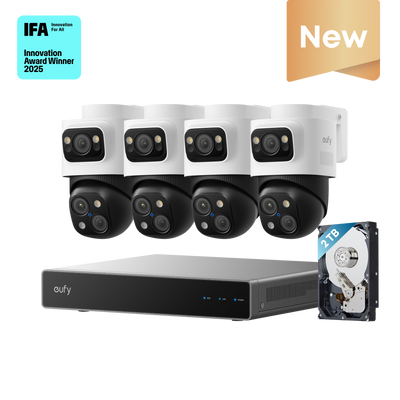The phrase “what is 2K resolution” often pops up in conversations about display quality, gaming, and even home security. Yet, many people still wonder how it differs from HD or 4K and why it's such a popular choice. Understanding how 2K fits into today's tech landscape helps you decide whether it's the right match for your screen or camera needs.

What Is 2K Resolution?
When people ask what resolution is 2K, they're referring to displays with roughly two thousand horizontal pixels. In technical terms, the Digital Cinema Initiatives (DCI) version measures 2048 x 1080 pixels, which became the industry's baseline for “2K.”
That's only part of the story. Over time, display manufacturers began using the term more loosely to describe higher-resolution consumer screens such as 2560 x 1440, often called Quad HD (QHD). Whether it's the DCI format or QHD, 2K delivers a noticeable boost in sharpness and clarity compared to standard 1080p.
In short, what is the resolution of 2K? It's any display with around two thousand horizontal pixels—offering more visual detail without the heavy processing demands of 4K.
How 2K Compares to Other Common Resolutions
2K sits comfortably between Full HD and 4K. It's a middle ground that offers better image definition than 1080p without overloading your hardware like 4K often does. Let's break down how it compares.
2K vs 1080p
Both 1080p (1920 × 1080) and 2K (2048 × 1080) share the same height, but 2K is 128 pixels wider. That modest increase adds about 140 thousand extra pixels overall, around 7 % more image data. While the difference isn't dramatic, 2K footage can look a bit smoother and cleaner, especially on larger displays where pixel edges become more noticeable.
When you watch side by side, 2K footage appears more refined. Edges are smoother, text looks cleaner, and subtle details—like textures or patterns—stand out more clearly. It's a modest jump in numbers, but a meaningful upgrade in visual quality.
From a practical view, 1080p remains a solid option for casual streaming and basic computing. However, 2K is ideal for users who rely on visual precision—graphic designers, video editors, and gamers who appreciate crisp, lifelike images.
2K vs 4K
If 2K improves upon HD, 4K doubles down on it. With 4096 x 2160 pixels, 4K packs four times as many pixels as 1080p and twice as many as 2K. That means higher clarity—but also more demanding performance requirements.
For smaller screens (24–27 inches), the visual gap between 2K and 4K isn't huge. You'll notice it more on large TVs or ultra-wide monitors, where 4K's density prevents text and visuals from appearing soft. But 2K remains easier on graphics cards, internet connections, and budgets.
Panel technology also plays a role. Displays with IPS panels generally produce richer color and wider viewing angles than TN panels, regardless of resolution. So while 4K offers incredible detail, a high-quality 2K IPS display often provides the best balance of sharpness, color, and cost.
When comparing what is 2K video resolution to 4K, think of 2K as the sweet spot: visually impressive, hardware-friendly, and versatile enough for most applications.
Here's a quick side-by-side look at how 2K stacks up against 1080p and 4K:
|
Feature |
1080p (Full HD) |
2K (DCI 2K / QHD) |
4K (UHD / DCI 4K) |
|
Pixel Dimensions |
1920 × 1080 |
2048 × 1080 (DCI) 2560 × 1440 (QHD) |
3840 × 2160 (UHD) 4096 × 2160 (DCI) |
|
Total Pixels |
≈ 2.07 million |
≈ 2.21 million (DCI) ≈ 3.69 million (QHD) |
≈ 8.29 million (UHD) ≈ 8.85 million (DCI) |
|
Aspect Ratio |
16 : 9 (≈ 1.78 : 1) |
≈ 1.90 : 1 (DCI) 16 : 9 (QHD) |
≈ 1.90 : 1 (DCI) 16 : 9 (UHD) |
|
Sharpness & Detail |
Baseline HD quality |
≈ 7 % sharper than 1080p (DCI) Clearly sharper (QHD) |
Up to 4× the detail of 1080p |
|
Typical Screen Sizes |
21 – 27 in monitors, HD TVs |
24 – 32 in monitors, mid-range laptops |
27 in + monitors, large TVs, cinema screens |
|
Performance Needs |
Low hardware load |
Moderate GPU / CPU requirements |
High GPU / CPU requirements |
|
Best For |
Casual viewing, streaming |
Gaming, design, video editing |
Cinematic editing, large displays |
|
Overall Impression |
Good quality baseline |
Balanced “sweet spot” between clarity and performance |
Highest detail but hardware demanding |
Why Is 1440p Sometimes Referred to as 2K?
You've probably seen “1440p” and “2K” used interchangeably—and for good reason. The confusion comes from how resolution is measured. “2K” refers to horizontal pixels, while “1440p” refers to vertical pixels.
A 2560 x 1440 display technically exceeds 2,000 horizontal pixels, but because it's close to that number, it became popularly known as “2K.” In professional cinema, the term still means 2048 x 1080, but in consumer tech, 1440p became the go-to definition.
So, when someone talks about a 2K monitor, they're usually referring to 1440p. The naming isn't exact—but the clarity and performance benefits are what really count.
Common Use Cases of 2K Resolution
The real reason 2K has become so common is its versatility. It's powerful enough for clear, detailed visuals but practical enough to run smoothly on everyday hardware.
Monitors and Laptops: Many mid-range and high-end monitors use 2560 x 1440 resolution, providing extra workspace for multitasking and sharper graphics. For laptops, this resolution strikes a perfect balance between battery efficiency and visual clarity.
Gaming and Entertainment: Gamers love 2K for its sweet spot between image detail and frame rates. It allows smoother gameplay than 4K without sacrificing sharpness. Streaming video in 2K also looks more natural and detailed than HD.
Televisions: While most TVs are now 4K, many still support 2K input, making them compatible with mid-range devices that don't yet stream in 4K.
Smartphones: Some flagship phones—like the latest premium models—feature 1440p screens that qualify as 2K. The result is razor-sharp text, vivid color, and lifelike image depth.
Security Cameras: In the security world, 2K is a major step up from standard HD security cameras. The added resolution can make all the difference when identifying faces, objects, or small details in footage.
Is 2K the Right Choice for You?
Choosing a resolution depends on how and where you use your screen. 2K fits best for those who want visual sharpness without the cost or complexity of 4K.
- Screen Size:2K resolution looks best on displays between 24 and 27 inches. Smaller screens may not show a huge difference from 1080p, while much larger ones benefit more from 4K.
- Viewing Distance:The closer you sit, the more noticeable 2K's extra pixels become. For typical desktop setups, it provides excellent clarity.
- Performance Needs:You don't need a top-tier graphics card to handle 2K, but a capable GPU helps unlock its full potential—especially for gaming or design.
Overall, 2K strikes a great balance: better detail than HD, smoother performance than 4K, and wide availability across modern devices.
Upgrading Security Camera Resolution
When upgrading home security, moving from HD to 2K or 4K brings a clear difference in detail. A higher-resolution feed means sharper faces, clearer movement, and more reliable evidence. Here's how a few eufy options showcase what modern 2K and 3K technology can do.
eufy SoloCam S340 (2K & 3K)
The SoloCam S340 (2K&3K) delivers dual-camera precision, offering both a wide and telephoto view for flexible coverage. Its 3K clarity captures fine details up to 50 feet away, while an 8× hybrid zoom ensures you can focus on what matters most. A built-in solar panel keeps it running indefinitely with minimal maintenance. Add 360° panning, and you've got a compact, wire-free system that guards every angle of your property.

eufy Floodlight Camera E340 (2K & 3K)
The eufy Floodlight Camera E340 (2K&3K) combines continuous recording with bright, motion-activated lighting for true around-the-clock protection. Its dual 2K/3K lenses deliver both broad coverage and telephoto close-ups. AI tracking automatically follows movement, while a 2,000-lumen spotlight and loud alarm deter intruders. With support for Wi-Fi 6 and local storage, it's ideal for anyone who wants both security and convenience without subscription fees.

NVR Security Camera S4 Max
Designed for larger properties, the NVR Security Camera S4 Max uses a triple-lens setup: a 4K wide-angle camera for full scenes and a 2K PTZ camera for precise zoom tracking. The system's AI can automatically follow subjects and coordinate across multiple cameras for seamless coverage. With 8-channel expandability, local video search, and built-in storage up to 16 TB, it delivers professional-grade protection in an easy plug-and-play design.

eufyCam S4
The eufyCam S4 blends flexibility with power. It combines a 4K bullet camera for static views and a 2K PTZ lens that can pan, tilt, and zoom to track motion. The SolarPlus™ 2.0 panel keeps it charged with as little as an hour of sunlight a day, while its dual motion sensors minimize false alerts. With color night vision, customizable zones, and local storage up to 256 GB, it offers all-day, all-weather security that adapts to your needs.

Conclusion
Understanding what is 2K resolution goes beyond numbers—it's about finding the right balance between clarity, performance, and practicality. 2K provides sharper visuals than HD, demands far less power than 4K, and adapts beautifully to monitors, laptops, and security systems. Whether you're enhancing your workspace, gaming setup, or home protection, 2K offers that “just right” combination of detail and efficiency that continues to make it a smart, future-proof choice.
FAQs
Is 2K the same as 1440p?
Not exactly, but they're very close. Technically, 2K refers to a display width of about 2048 pixels, while 1440p means 2560 × 1440 pixels. However, because both have around two thousand horizontal pixels, people often use the terms interchangeably—especially for computer monitors and gaming screens. In everyday use, 2K and 1440p usually mean the same thing.
Is 1440p resolution 2K or 4K?
1440p is considered 2K, not 4K. The “2K” label comes from its width of about two thousand pixels, while 4K screens have roughly four thousand. In simple terms, 1440p (2560 × 1440) sits right between Full HD (1080p) and 4K (2160p), giving users a sharper, smoother display without the higher system demands of 4K.
Is 2K resolution the same as 1080p?
No, 2K offers more pixels and better image clarity than 1080p. While 1080p displays have 1920 × 1080 pixels, 2K increases the width to about 2048 or even 2560 pixels, depending on the format. That means more detail, smoother edges, and a noticeably sharper picture—especially useful for gaming, video editing, and larger screens.
Is 2K resolution Full HD?
No, 2K is a step above Full HD. Full HD refers to 1080p, which is 1920 × 1080 pixels. 2K, on the other hand, typically measures 2048 × 1080 or 2560 × 1440, offering a higher pixel density. The result is a clearer, crisper image with more visible detail, especially on medium to large monitors and TVs.
Is 2K better than 4K?
It depends on what you need. 4K delivers higher resolution and finer details, making it ideal for large screens and professional video work. However, 2K offers smoother performance, lower hardware demands, and often looks nearly as sharp on smaller displays. For most users, 2K is the perfect balance between clarity, cost, and efficiency.















